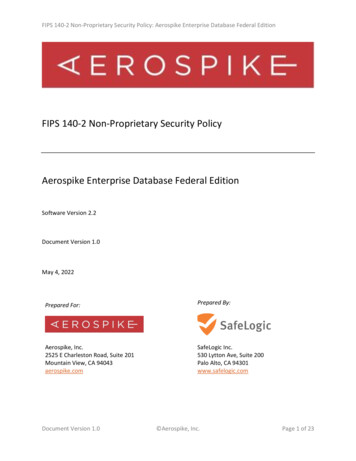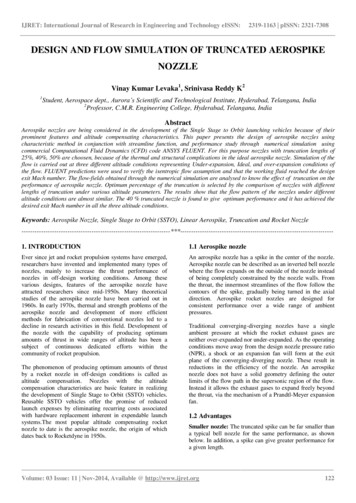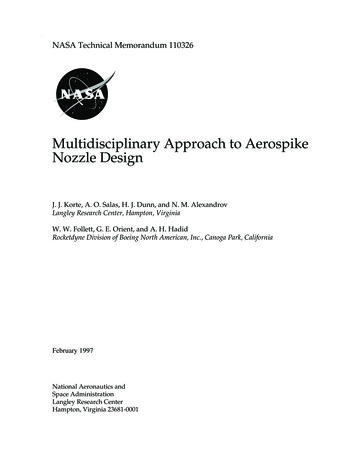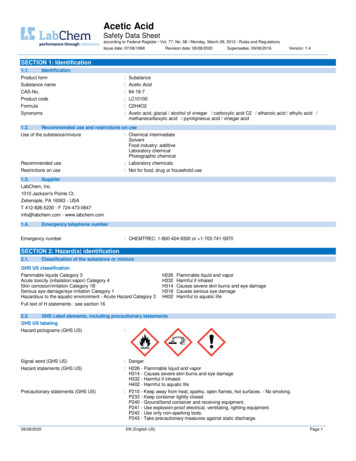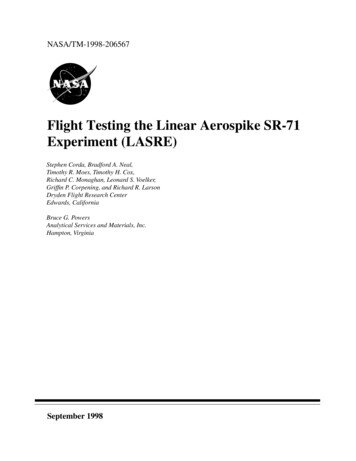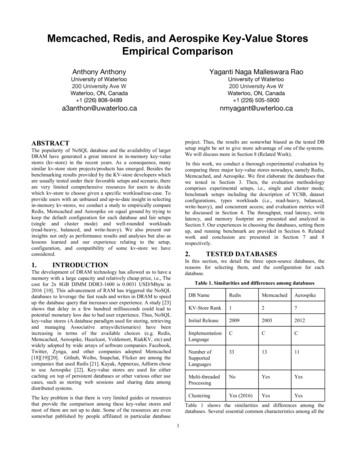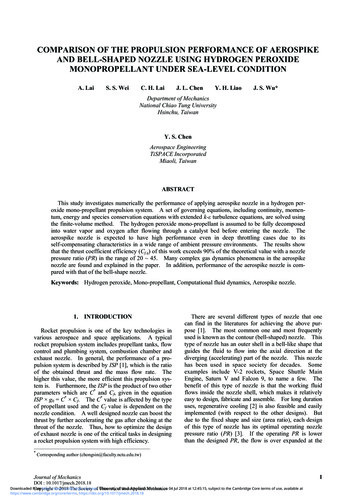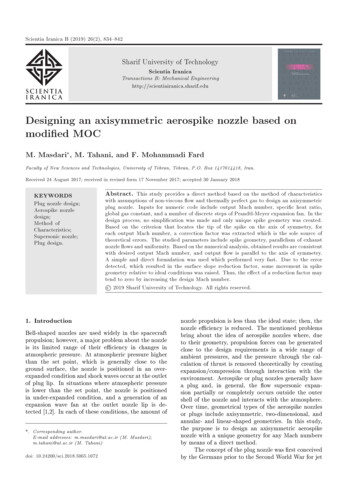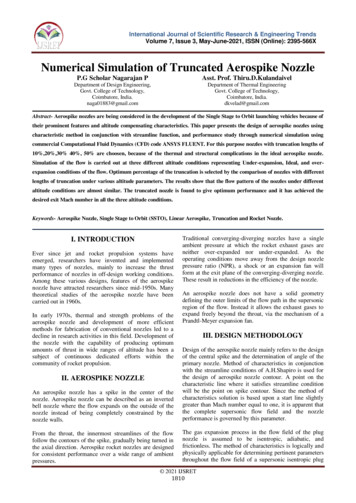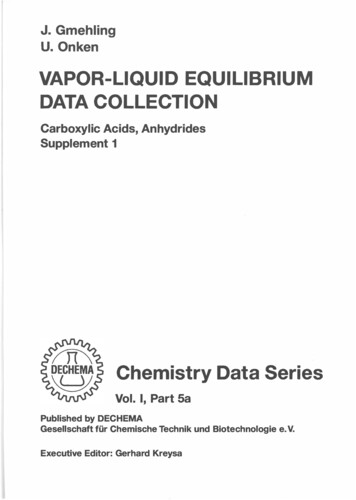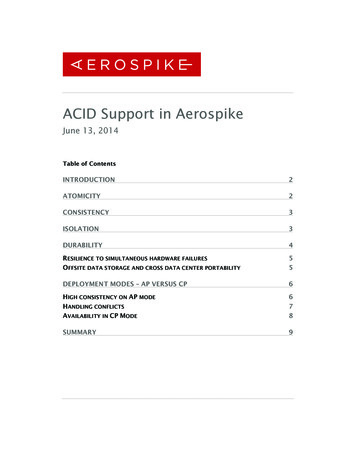
Transcription
ACID Support in AerospikeJune 13, 2014Table of ON3DURABILITY4RESILIENCE TO SIMULTANEOUS HARDWARE FAILURESOFFSITE DATA STORAGE AND CROSS DATA CENTER PORTABILITY55DEPLOYMENT MODES – AP VERSUS CP6HIGH CONSISTENCY ON AP MODE6HANDLING CONFLICTSAVAILABILITY IN CP MODE78SUMMARY9
IntroductionThe CAP Theorem postulates that only two of the three properties of consistency,availability, and partition tolerance can be guaranteed in a distributed system at aspecific time. Since availability is paramount in most deployments, the system can eitherprovide consistency or partition tolerance. Note, however, that these three properties aremore continuous rather than binary. Aerospike is by and large an AP system that provideshigh consistency by using the following techniques: Trade off availability and consistency at a finer granularity in each subsystem Restrict communication latencies between nodes to be sub-millisecond Leverage the high vertical scale of Aerospike (1 million TPS and multiple terabytecapacity per node) to ensure that cluster sizes stay small (between 1 and100 nodes) Virtually eliminate partition formation as proven by years of deployments in datacenter and cloud environments Ensure extremely high consistency and availability during node failures androlling upgrades (in the absence of partitions that are rare anyway) Provide automatic conflict resolution to ensure newer data overrides older dataduring cluster formationMore details of how Aerospike provides ACID consistency in the presence of node failuresare described below.AtomicityFor read/write operations on a single record, Aerospike makes strict guarantees about theatomicity of these operations: Each operation on a record is applied atomically and completely. For example, aread or a write operation on multiple bins in a record is guaranteed a consistentview of the record. The system performs all the checks upfront on the master thatcould lead to potential failures and creates an in-memory copy of the final record.If errors are encountered, no new record is written to storage and the old recordwill be kept intact. The client will be notified about the reason for the failure.Once the system is past the checks, there should not be any reason why the writeshould fail. After a write is completely applied and the client is notified of success, allsubsequent read requests are guaranteed to find the newly written data: there isno possibility of reading stale data. Therefore, Aerospike transactions provideimmediate consistency.In addition to single record read/write operations, Aerospike supports distributed multikey read transactions (batch/scan/query) using a simple and fast iteration interface wherea client can simply request all or part of the data in a particular set. This mechanism isJune 13, 2014ACID Support in Aerospike2
currently used for database backup and basic analytics on the data and delivers extremelyhigh throughput.ConsistencyIn the context of RDBMS, consistency implies that the data must honor all the rulesspecified by correctness rules like check-constraints, referential integrity constraints(primary - foreign key), etc., at the end of every transaction. These are not currentlyapplicable to Aerospike, as the database does not support such constraints yet.However, in case of distributed systems, consistency can have a different meaning.Consistency as defined in the CAP theorem requires that all copies of a data item in thecluster are in sync. For operations on single keys with replication and secondary indexes,Aerospike provides immediate consistency using synchronous writes to replicas within thecluster, i.e., the client will be intimated about the successful write only if the replica isalso updated. No other write is allowed on the record while the update of its replica ispending. This enables Aerospike to achieve a high level of consistency even in thepresence of node failures and rolling upgrades provided the cluster exhibits no networklevel partitioning.Multi-key read transactions are implemented as a sequence of single key operations anddo not hold record locks except for the time required to read a clean copy. Thus themulti-key read transaction provides a consistent snapshot of the data in the database (i.e.,no “dirty reads” are done).In Aerospike, it is possible to relax immediate consistency if performance requirementsoutweigh the benefits of high consistency. For example, this may be necessary when writelevels of the data are much higher than the read rates. Aerospike’s support for relaxingconsistency models gives operators the ability to maintain high performance during thecluster recovery phase after node failure. For instance, read and write transactions torecords that have unmerged duplicates can bypass the duplicate merge phase.IsolationAll record writes in Aerospike are directed to the master nodes that atomically co-ordinatethe writes across replica nodes. Aerospike provides read-committed isolation level usingrecord locks to ensure isolation between multiple transactions. Therefore, when a bunchof read and a write operations for a record are pending simultaneously in parallel, theywill be internally serialized before completion though their precise ordering is notguaranteed.June 13, 2014ACID Support in Aerospike3
Aerospike also supports an optimistic concurrency control scheme using Check and Set(CAS) from the application layer. This allows multiple read-modify-write cycles from theclient to not overwrite each other. User defined functions (UDF) running inside thedatabase cluster nodes avoid the need to perform a read-modify-write cycle from theapplication layer as the UDF operations on a record are also serialized using recordlocks. So, when an operation within a UDF reads a copy of the record, it is guaranteed thatno other concurrent transaction can change the value of this record until the execution ofthis UDF code is completed.For multi-key read operations, the Aerospike client anchors the iteration operation andrequests data from all the cluster nodes in parallel. Snapshots of the index are taken atvarious points to allow minimal lock hold times with reference counting so that the treelocks are held for the minimum possible time. As data is retrieved in parallel from theworking nodes, it is forwarded to the client, with client flow control exerting backpressureon the distributed transaction.DurabilityAerospike provides durability using multiple techniques: Persistence by storing data in flash/SSD on every node and performing directreads from flash Replication within a cluster by storing copies of the data on multiple nodes Replication across geographically separated clustersDurability is achieved by SSD based storage and replication. The replication to replica (orprole) nodes is done synchronously. I.e., the client application will be intimated only afterthe record is successfully written on the replica nodes. So, even if one node failed for anyreason, we will have one more copy in another node thereby ensuring durability of thecommitted records. This is similar to the data log file approach of traditional RDBMSwhere, If a data file is lost, the data can be recovered by replaying the log file. However, incase of Aerospike when one copy of the data is lost on a node, the data need not berecovered. Instead, the latest copy of the lost data is instantly available in one or morereplica nodes in the same cluster as well as in nodes residing in remote clusters.Aerospike also supports rack aware replication. Generally, in datacenters, multiplemachines are mounted on several racks where each rack may share commoninfrastructure like power sources, network switches, etc. There is a slightly higherprobability that all the machines on a rack will fail together (compared to the probabilityof all nodes across multiple racks failing at the same time). To mitigate this real-lifesituation, Aerospike lets nodes of the same cluster to be equally distributed acrossmultiple racks. If such rack-aware configuration is enabled, Aerospike will avoid puttingboth master and replica copies of a partition within machines that are in the same rack.Therefore, even in the situation where an entire rack of machines fail together, there willJune 13, 2014ACID Support in Aerospike4
be a copy of all of the data in the failed rack elsewhere in the cluster, thereby ensuringhigh data durability.On top of this, Aerospike’s cross data center (XDR) support can be used toasynchronously replicate data to a geographically separated cluster providing anadditional layer of durability. This will ensure sure that all of the data in the Aerospikedatabase survives on a remote cluster even if an entire cluster fails and data isunrecoverable.Resilience to simultaneous hardware failuresIn the presence of node failures, applications written using Aerospike clients are able toseamlessly retrieve one of the copies of the data from the cluster with no special effort.This is because, in an Aerospike cluster, the virtual partitioning and distribution of datawithin the cluster is completely invisible to the application. Therefore, when applicationlibraries make calls using the simple Client API to the Aerospike cluster, any node cantake requests for any piece of data.If a cluster node receives a request for a piece of data it does not have locally, it satisfiesthe request by generating a proxy request fetch the data from the real owner using theinternal cluster interconnect and subsequently replying to the client directly. TheAerospike client-server protocol also implements caching of latest known locations ofclient requested data in the client library itself thus minimizing the number of networkhops required to respond to a client request.During the period immediately after a cluster node has been added or removed, theAerospike cluster automatically transfers data between the nodes to rebalance andachieve data availability. During this time, Aerospike’s internal “proxy” transactiontracking allows high-consistency to be achieved by applying reads and writes to thecluster nodes which have the data, even if the data is in motion.Offsite data storage and cross data center portabilityAerospike provides online backup and restore, which, as the name indicates, can beapplied while the cluster is in operation. Even though data replication will solve most realworld data center availability issues, an essential tool of any database administrator is theability to run backup and restore. An Aerospike cluster has the ability to iterate all datawithin a namespace (similar to a map/reduce). The backup and restore tools are typicallyrun on a maintenance machine with a large amount of inexpensive, standard rotationaldisk.Aerospike backup and restore tools are made available with full source. The file format inuse is optimized for high speed but uses an ASCII format, allowing an operator to validatethe data inserted into the cluster, and use standard scripts to move data from one datastore to another. The backup tool splits the backup into multiple files. This allowsrestores to occur in parallel from multiple machines in the case of needing a very rapidresponse to a catastrophic failure event.June 13, 2014ACID Support in Aerospike5
Deployment modes – AP versus CPIn the presence of failures, the cluster can run in one of two modes – AP (available andpartition tolerant) or CP (consistent and partition tolerant). The AP mode that Aerospikesupports today prioritizes availability and therefore can be consistent only whenpartitions do not occur. In the future, Aerospike will add support for CP mode as anadditional deployment option.High consistency on AP modeA key design point of Aerospike is to setup cluster nodes that are tightly coupled so thatpartitions are virtually impossible to create. This means that a replicated Aerospikecluster provides high consistency and high availability during node failures and restartsso long as the cluster does not split into separate partitions.Here are the key techniques used in Aerospike that minimize and virtually eliminatenetwork based partitioning: Fast and robust heartbeats: Aerospike heartbeats are sent at a regular pace.Note that the cluster nodes are expected to be close to each other thus requiringless than millisecond latency for node-to-node heartbeat messages. Heartbeatscan be sent on UDP (in multicast mode) or on TCP (mesh mode), which is morereliable. On top of this Aerospike has a secondary heartbeat mechanism wherethe data transfer will augment the primary heartbeats. So, even if the primaryheartbeat fails, if there are continuous read/write operations in the database, thecluster will be held together. Consistent Paxos based cluster formation: Aerospike uses a fast Paxos basedalgorithm to coalesce the cluster. The short heartbeat interval is critical since itenables the Paxos based algorithm to discover node arrivals and node departuresextremely quickly and then re-coalesce the new cluster within tens ofmilliseconds. This is a case where Aerospike prioritizes consistency overavailability for fleetingly small moments (low milliseconds) and the systemquickly recovers availability as soon as the cluster coalesces. In practice, thisshort-term unavailability during cluster formation preserves consistency and isbarely registered as a glitch on a system that routinely handles hundreds ofthousands of transactions per second. Cluster node additions or removals arequite rare and these glitches are barely noticeable to the application. High performance results in smaller clusters: Aerospike can perform atextremely high scale, typically an order of magnitude better than comparablesystems. Thanks to efficient hash-based algorithms, which avoid any hotspots,Aerospike can handle huge amounts of read/write transactional throughputwithout compromising on the performance or latency on a single node. By usinghigh capacity SSDs, each node of the cluster can hold and serve a huge amount ofdata thus keeping the size of the cluster relatively small. Basically, an Aerospikecluster is virtually ten times smaller than comparable clusters of other databasesthat can handle the same load. Smaller cluster sizes means that in most cases, allAerospike cluster nodes can be connected using the same switch with adequatefail-safe backup. This is recommended but not mandatory.In addition to avoiding network partitioning, Aerospike uses additional techniques thatensure consistency during node failures and rolling upgrades:June 13, 2014ACID Support in Aerospike6
Single node failures: When using replication factor 2, if a single node failsthen the remaining nodes will have all the data of the cluster. We do automatic rebalancing (migration) of the data between the surviving nodes. While themigration is going on Aerospike allows writes to continue. To make sure that nowrites are lost in a race condition between the act of re-balancing and acceptingwrites, Aerospike maintains a journal of changes that will be reapplied, afterproper checks, at the end of a partition’s migration. Rolling upgrades: Upgrading the software is a common requirement. Thesoftware may be upgraded in more number of cases (thereby necessitating anode down) than the case of unplanned failure of the nodes. This is a non-issuewith Aerospike because of how Aerospike handles single node failure cases verygracefully without any data loss, as explained above. Transaction repeatable read setting: When multiple nodes have merged into thecluster in a short amount of time, there may be many copies of the record createdin the cluster. But only one version of the record is the correct one. To overcomesuch a scenario, Aerospike provides a configuration option to enable repeatableread. For every read operation, when repeatable read is enabled, Aerospike willconsult all nodes in the cluster that claim to have data belonging to the partition,pick the most recent record (correct record), and return it to the client. Thesystem will continue to use this merge algorithm during read operations until allthe copies of a partition are merged as part of the migration process. Therefore,there cannot be a situation where different read requests will return differentversions of the data (repeatable read requires this). Note that this option comesat the cost of higher latency caused by checking all copies of a record in thecluster before returning to the client. In this case, therefore, the applicationachieves higher consistency while getting lower availability that is manifested ashigher latency for the read operation.Aerospike continues to improve reporting of consistency errors by performing all thepreliminary checks up front before writing to the disk on the master. This will ensure thatwriting on the master node is fail-safe. However, the system could fail in writing to one ormore replica nodes. If the replica node communicates back an error, the write is retried as the prolecan fail only due to temporary reasons like timeout or running out of disk space(which is continuously garbage collected). The tougher case is the one in which a prole did not communicate back anythingto the master and the network connection is lost. The master will not know if therecord was successfully written or not. In this case, the client should receive an"Unknown" transaction state back.Handling conflictsFinally, we describe how Aerospike handles the case if a partitioning of the cluster were tohappen. Note that, in AP mode, when a cluster splits into multiple partitions or factions,each faction of the cluster continues to operate. One faction – or the other – may not haveall of the data, so an application reading data may have successful transactions statingthat data is not found in the cluster. Each faction will begin the process of obeying thereplication factor rules (replicating data) and may accept writes from clients. Applicationservers that read from the other faction will not see the applied writes, and may write tothe same primary keys. At a later point, if the factions rejoin, data that has been written inJune 13, 2014ACID Support in Aerospike7
both factions will be detected as inconsistent. Two policies may be followed. EitherAerospike will auto-merge the two data items (default behavior today) or keep both copiesfor application to merge later (future).Auto merge works as follows: TTL (time-to-live) based: The record with the highest TTL wins Generation based: The record with the highest generation winsApplication merge works as follows: When two versions of the same data item are available in the cluster, a read ofthis value will return both versions, allowing the application to resolve theinconsistency. The client application – the only entity with knowledge of how to resolve thesedifferences – must then re-write the data in a consistent fashion.Availability in CP ModeIn CP mode, when the cluster splits into two or more active clusters, availability needs tobe sacrificed. For example, the minority quorum(s) could be made to halt. This actionprevents any client from receiving inconsistent data, but will reduce availability. Aerospikesmart clients can also be made to detect cluster-partitioning occurrences and actappropriately to restrict access to exactly one of the partitions. In this scenario, per theCAP theorem, the system will be prioritizing consistency over availability in order to allowfor partition-tolerance.There will be use cases where availability can be sacrificed and a CP system is needed. Toenable Aerospike to be used in more domains, we plan to add a configuration foroperating the cluster in CP mode in addition to the AP mode that is supported now. Theactual mode of an individual cluster will be configurable by the operator based on theirneeds.Aerospike's first step towards a CP system would be to support a static cluster size. Thestatic cluster concept works as follows: The idea of static cluster is to predefine the nodes of the cluster. The systemadministrator is allowed to specify the exact set of cluster nodes and engage a"static-cluster" switch so that the composition of the cluster is fixed to includeexactly all of the current nodes of the cluster. While the static-cluster switch is engaged, any cluster state change will notautomatically result in changes to the partition map. The partition mapdetermines how master and replicas of partitions are stored in nodes. I.e., thepartition map is fixed and no migration of data is allowed whenever the staticcluster switch is engaged.June 13, 2014ACID Support in Aerospike8
The operator needs to disengage the static-cluster switch before the clusterconfiguration can be changed in a controlled manner to add or remove nodes.The operator then needs to wait for all migrations to be completed before reengaging the static-cluster switch. If the cluster is split into one or more islands, and if the client sends a request toone of the nodes in an island, the following happens: oIf the request is a read request, and one of the nodes in the island has acopy of the data, the read request will be serviced.oIf the request is a write request, and the node is the master (or themaster is in the island), it will perform the write only if all the replicas arein the same island. Our experience tells us that when there is networkbased cluster partitioning, it is normally one or a very few nodes that getseparated. In the fairly common scenario where only one node getsseparated from its cluster, only 1/nth of the data is unavailable for writes(where n is the number of nodes in the cluster). This may be quiteacceptable in order to obtain full consistency in the presence ofpartitions.Bigger sized islands may form if the nodes are connected through a hierarchy ofswitches and the intermediate (non-leaf) switch fails. So, we intend to continueour current recommendation that all the nodes of Aerospike should be connectedto the same switch, if possible. However, it is not mandatory.SummaryThis document has provided a brief technical overview of ACID support in Aerospike. Sofar, Aerospike has focused on continuous availability and provides the best possibleconsistency in an AP system by using techniques to avoid partitions. Going forward, thesystem will be enhanced to alternatively support a CP configuration that will allowcomplete consistency in the presence of network partitioning by reducing availability.June 13, 2014ACID Support in Aerospike9
Aerospike cluster automatically transfers data between the nodes to rebalance and achieve data availability. During this time, Aerospike's internal "proxy" transaction tracking allows high-consistency to be achieved by applying reads and writes to the cluster nodes which have the data, even if the data is in motion.
